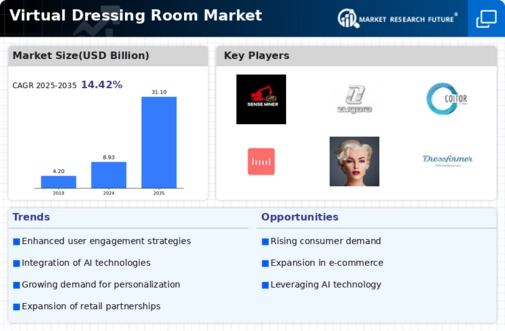Top Industry Leaders in the Virtual Dressing Room Market

Competitive Landscape of Virtual Dressing Room Market
The virtual dressing room (VDR) market is burgeoning, fueled by e-commerce growth, augmented reality (AR) advancements, and consumer desire for enhanced online shopping experiences. This dynamic landscape boasts a diverse range of players vying for market share, employing various strategies to capture consumer attention and secure brand loyalty.
Key Players Shaping the Game:
- SenseMi
- Zugara, Inc.
- Coitor IT Tech
- REACTIVE REALITY GMBH
- Fit Analytics
- 3D-A-PORTER LTD.
- triMirror
- Dressformer
- 3DLOOK Inc.
- ELSE Corp srl
- Elpro Technologies
- Fitle
- Fitnect Interactive
- True Fit Corporation
- SIZEBAY, among others
Strategies Fueling Growth:
- AR Integration: Integrating AR technology enhances the VDR experience. By superimposing clothes onto a user's avatar, brands can offer a realistic simulation of fit and style, improving customer engagement and satisfaction.
- Personalization and Recommendation: Advanced algorithms analyze user data, body scans, and purchase history to recommend outfits and sizes, creating a more tailored shopping experience. This builds customer trust and increases basket size.
- Multi-channel Approach: VDR solutions are expanding beyond online shops, finding their way into physical stores through smart mirrors and interactive displays. This omnichannel approach caters to diverse shopper preferences and strengthens brand reach.
- Social Media Integration: Brands are leveraging social media platforms like Instagram and Snapchat to offer virtual try-on features as interactive filters. This gamifies the shopping experience and reaches a wider audience.
Factors for Market Share Analysis:
- Technological Innovation: Companies with cutting-edge AR and personalization capabilities, along with seamless integration across platforms, stand a better chance of securing market share.
- Global Reach and Partnerships: Brands with widespread geographic presence and strong partnerships with retailers and technology providers hold an advantage in expanding their reach and market penetration.
- Data Security and Privacy: Ensuring user data security and transparency in data usage is crucial in building consumer trust, especially with body scanning technologies involved.
- Cost-effectiveness and Scalability: Affordable and scalable VDR solutions make them accessible to a wider range of brands, fostering market growth.
New and Emerging Companies:
- SizeTech: This startup utilizes AI and data analysis to recommend clothing sizes based on user input and purchase history. Their focus on size inclusivity caters to a growing consumer demand.
- Mirror Lab: This company has developed interactive smart mirrors for physical stores, allowing customers to virtually try on clothes and receive styling recommendations. This bridges the gap between online and offline shopping experiences.
- Drest: This social commerce platform combines VDR technology with a virtual closet and community features, allowing users to curate outfits, share styles, and shop curated looks. This gamifies the fashion experience and builds brand engagement.
Current Investment Trends:
- Venture Capital: VDR startups are attracting significant VC investment, with over $200 million raised in 2023 alone. This indicates growing investor confidence in the market's potential.
- Strategic Partnerships: Major brands are entering strategic partnerships with VDR solution providers to integrate the technology into their platforms and stores. This trend fosters further market consolidation and tech development.
- Focus on R&D: Leading VDR companies are investing heavily in R&D to develop more advanced features, such as body shape customization, hyper-realistic garment rendering, and integration with other technologies like virtual reality.
Tech Advancements and Integration:
- 3D body scanning and avatar creation: Advanced body scanning technologies are creating more realistic and accurate virtual avatars, leading to better garment fit simulations. (Oct 2023)
- Augmented reality (AR) integration: AR mirrors and apps allow customers to virtually try on clothes in real-time, overlaying garments on their bodies. (Dec 2023)
- Personalization and recommendations: VDRs with AI-powered personalization engines can recommend outfits based on individual preferences and body types. (Jan 2024)
Industry Partnerships and Collaborations:
- Retailers and tech companies: Major retailers like Macy's and H&M are partnering with tech companies like Perfitly to implement VDRs in their stores and online platforms. (Nov 2023)
- Fashion brands and VDR providers: Fashion brands are collaborating with VDR providers like DressX and Draped to offer virtual try-on experiences for their collections. (Jan 2024)










